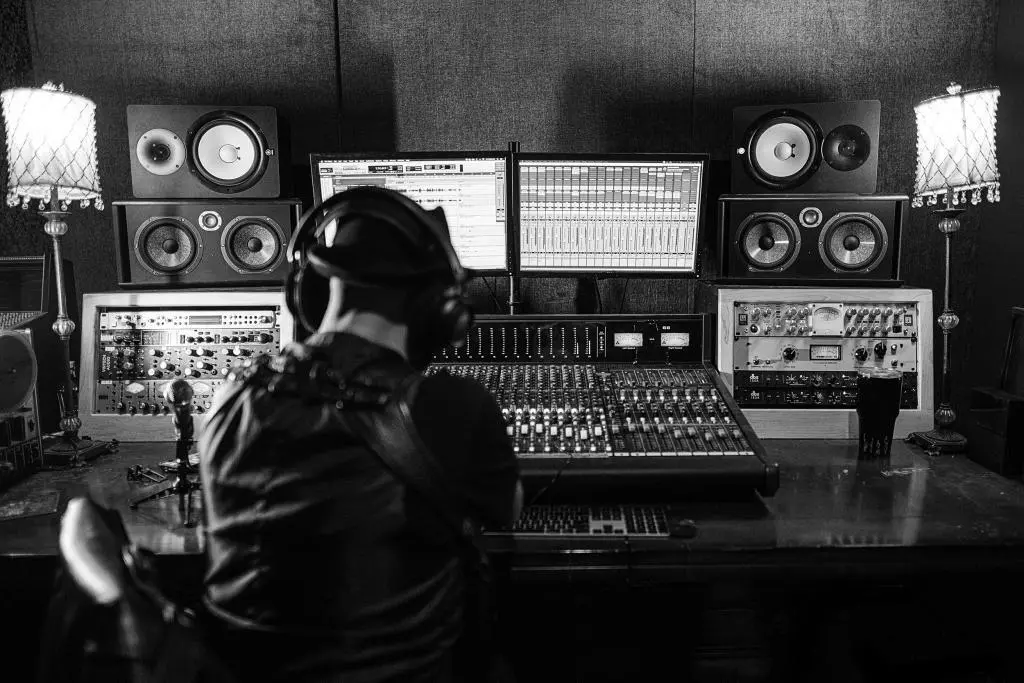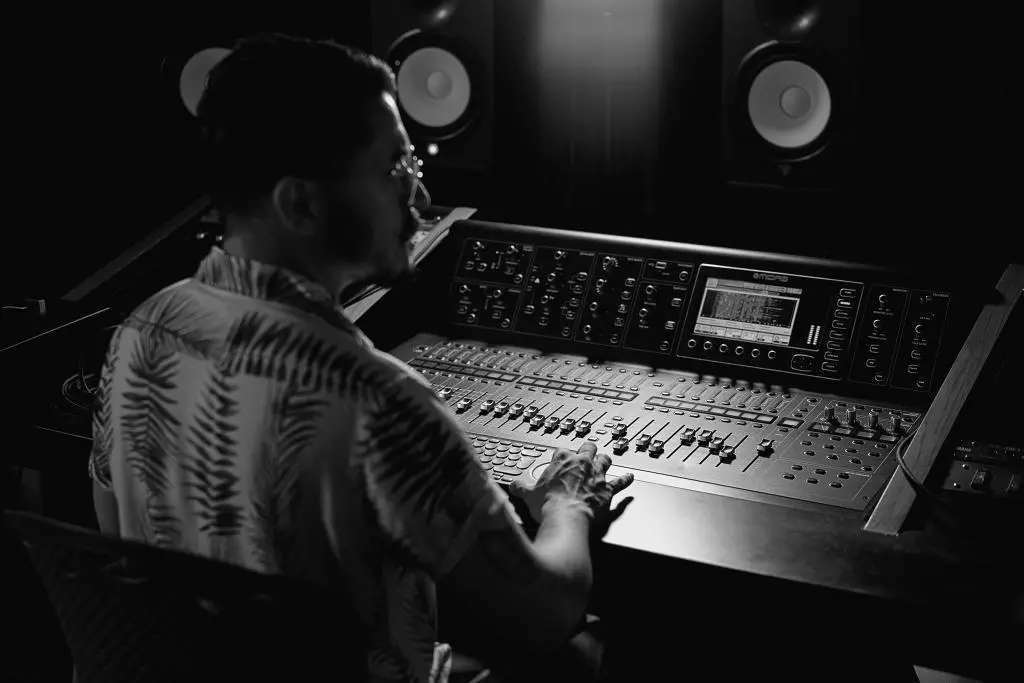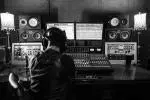RMS stands for “root mean square” and is a measurement used in audio to determine average loudness levels.
It provides a more accurate picture of how humans perceive loudness compared to peak metering. Understanding RMS is crucial for anyone involved in music production or audio engineering.

What is RMS: Table of Contents
Getting RMS levels right is an essential part of mixing and mastering. If the RMS level is too low, your track won’t be loud enough to compete with professional releases. If it’s too high, you risk introducing distortion and ruining dynamics. Striking the right balance takes skill, but having a solid handle on RMS is the first step.
RMS calculations average out peaks and low points in an audio signal. Our ears don’t hear short peaks as dramatically louder. We perceive loudness based on the overall average strength. RMS provides a metering standard that aligns with this human perception.
Knowing the exact RMS level of your mix compared to commercial references can prevent your music from sounding quiet and lacking impact. An accurate reading lets you maximize loudness without over-compressing and sacrificing dynamics that give life to a mix. Understanding RMS also helps when setting target loudness levels for streaming platforms.
While LUFS has emerged as an even more accurate loudness standard, RMS still has an important role in mixing and mastering workflows. Even advanced meters incorporate RMS readings alongside LUFS values. Whether you’re an aspiring producer or seasoned engineer, learning the ins and outs of RMS is essential for taking your audio skills to the next level.
Calculating RMS Values for Audio Signals
Before we dive into how RMS is used in audio, let’s look at what it means mathematically. RMS is a specialized way of determining the average value of a signal that fluctuates above and below zero. This makes it ideal for calculating average loudness levels in audio waveforms.
What is Root Mean Square?
The “root mean square” formula provides a meaningful average by squaring the values, calculating the mean, then taking the square root. Here is the RMS equation:
RMS = √(x12 + x22 + … + xn2) / n
Where x1, x2, etc. are the sample values and n is the number of samples in the time window.
This approach prevents negative and positive values from canceling each other out, which would happen with a simple mean. RMS accounts for the fact that both positive and negative excursions in a waveform represent acoustic energy.
For audio signals, the fluctuating waveform represents corresponding changes in air pressure over time. RMS considers the true average intensity of this pressure that our ears perceive as volume or loudness.
Simple averaging would result in a value of zero for a symmetric waveform. RMS accurately reflects the power contained in the signal. That’s why it provides a much better tool for understanding loudness than basic arithmetic means.
How RMS is Calculated for Audio
When applied specifically to audio signals, there are a few additional factors that go into RMS calculations:
- The root mean square equation shown above is still used to find the average.
- The measurement is taken over a defined time window, typically around 300ms for audio applications.
- The purpose is to average out any peaks that occur within that window. This prevents brief spikes from skewing the perceived loudness up or down dramatically.
Think of a snare drum hit. The initial crack will result in a sharp peak way above the rest of the music. But that peak rapidly decays.
If we measured RMS instantaneously, that one hit could seem excessively loud compared to the rest of the mix. By averaging over 300ms, that peak gets blended with lower sections before and after it, giving a reading more in line with how our ears hear the overall loudness.
Recording audio digitally allows DAWs to slice sound into tiny samples and calculate RMS for each desired time window. The processor computes the average intensity for 300ms, then moves ahead in small increments, repeating the calculation continuously.
This generates an RMS value that more closely matches our perception, riding the peaks and valleys rather than wildly jumping with every spike. Adjusting a mix based on RMS readings helps translate mixes to be competitively loud on any speaker system.
Peak vs RMS Meters
Understanding the difference between peak and RMS meters is crucial for interpreting your DAW’s readings accurately.
Peak meters show the maximum level at each instantaneous point in time. They display the literal peaks in the waveform – the highest positive and negative excursions.
Peak meters are essential for avoiding clipping. The peak display warns if your signal exceeds 0 dBFS at any moment, which would result in distorted clipping. Peak readings also show precisely how dynamic your mix is by revealing the crest factor – the difference between peak and average levels.
RMS meters take a wider view by averaging loudness over time. You’ll notice RMS meters move more slowly and smoothly than suddenly-jumping peak displays. This reflects how our ears perceive loudness based on the ongoing average intensity, not split-second spikes.
Since humans hear loudness based on sustained energy over time, RMS meters provide a reading closer to perceived volume. You can have a high peak level but lower RMS if the peak is a short transient. Similarly, a mix with lower peaks but more consistent higher levels can have a greater RMS loudness.
When balancing your mix, pay attention to both displays. Use peak meters to avoid clipping, while optimizing RMS levels to maximize loudness and match the energy of professional references. Having awareness of both momentary peaks and time-averaged loudness gives the most complete picture.
Should I Use Peak or RMS Metering?
With both peak and RMS metering available, when should you use each type? Here are some guidelines:
Peak metering is essential when:
- Checking for clipping – Make sure there are no spots exceeding 0 dBFS that could cause distortion. Watch the peak meter when adding effects or maximizing loudness.
- Viewing instantaneous dynamics – Peak meters reveal the crest factor and exact moment-to-moment variation in levels. Use them to detect any unexpectedly loud transients.
RMS metering is more useful when:
- Setting overall loudness – RMS provides the average loudness over time that best aligns with human perception. Match RMS levels to commercial references.
- Evaluating processing – Watch how compression, limiting, and other effects influence the RMS reading to understand their impact on loudness.
- Optimizing for streaming – Target RMS levels can help you optimize loudness for YouTube, Spotify, etc. without over-compressing.
For a complete picture:
- Use both meter types – Peak and RMS provide complementary information that makes each one more insightful. Relying solely on peak or RMS metering gives an incomplete perspective.
- Learn how they interact – Note how processing affects the relationship between peak and RMS readings. This reveals helpful information about how dynamics are being altered.
- Balance the priorities – Use peak metering to avoid technical issues like clipping while optimizing RMS levels for maximize perceived loudness.

RMS Loudness in Music Production
Now that we understand what RMS is and how it’s calculated, let’s explore some ways it’s applied in music production. Optimizing RMS levels is a crucial part of mixing and mastering loud, competitive tracks.
What is a Good RMS Level for Mixing/Mastering?
There’s no single “perfect” RMS level for all music. However, analyzing commercial references in your genre provides helpful targets:
- Modern pop/rock typically averages around -10 to -8 RMS. The “loudness wars” of the 2000s pushed levels higher through extensive compression.
- Dance/EDM often peaks close to -6 RMS. Maximizing loudness is a priority for high-energy club music.
- Softer genres like folk and jazz may average -14 RMS. More dynamic range is preserved to retain naturalness.
During mixing, leave some headroom below your reference tracks’ RMS levels. This prevents your master from needing excessive limiting.
When mastering, you can hone in on your genre’s competitive RMS numbers. But don’t over-compress solely to hit a loudness target. Find a balance between RMS levels, dynamics, and clarity.
Use RMS readings when referencing your mix against commercial tracks. Matching RMS provides a better indicator of perceived loudness than aligning peak levels or by ear alone. Tuning your ears to recognize competitive RMS values takes practice but is a valuable mixing skill.
How to Check RMS in Your DAW
Monitoring RMS levels is easy with built-in or third-party plugins. Here are some options:
DAW stock plugins
Many DAWs now include RMS meters:
- Logic Pro X – Loudness Meter
- Cubase – Control Room metering
- Pro Tools – AudioSuite Loudness Meters
Enable these to view RMS alongside peak readings. Place an instance on your master bus to gauge overall loudness.
Third-party plugins
If your DAW lacks RMS meters, plenty of affordable third-party options exist:
- Klanghelm VUMT – Classic VU-style moving needle metering
- ToneBoosters Plugins – Bar graph and numerical RMS displays
- TM Audio Loudness Meter – RMS, LUFS, true peak, and more
Use across your mix
Add instances of your chosen RMS meter to key instruments, like lead vocals and drums. This helps ensure elements have comparable relative loudness in the composite.
Compare to references
Load a commercial reference track into another track and add RMS metering to it. Now you can monitor your RMS levels against your genre’s competitive releases.
Experiment with different metering plugins and find an RMS display that provides the most helpful at-a-glance view while mixing and mastering.
Does a Higher RMS Mean a Better Mix?
It’s tempting to think pushing RMS levels higher and higher will make your mix sound better. But this isn’t necessarily true:
- Higher RMS doesn’t guarantee a “better” mix. An RMS reading just provides technical information about average loudness. Artistic preferences matter too.
- Ultra-loud RMS levels can undermine musical dynamics. Your song could end up sounding flat and lifeless if you destroy dynamics just to boost RMS.
- Ear fatigue occurs more easily at higher volumes. Even if technically louder, a hot RMS level may be less enjoyable to listen to over time.
- Streaming platforms turn down overly loud audio. Normalization could negate RMS maximization anyway, while degrading sound quality.
There is no universally ideal RMS target – it depends on genre, taste, and context. The key is finding the sweet spot between loudness and dynamics that fits your vision.
When referencing commercial tracks, don’t assume higher RMS is always better. Listen critically to analyze if boosting loudness in your mix adds to or detracts from the emotion and impact you want to achieve.
Let your creative objectives guide RMS optimization, not technical numbers alone. RMS provides helpful information, but your ears and musical sensitivity should have the final say.
How to Increase RMS Levels
If your RMS levels need a boost, here are some methods while retaining musicality:
- Subtle compression – Light ratio and threshold settings add density without crushing dynamics.
- Multi-band compression – Target problem frequencies dragging RMS down without compressing evenly.
- Efficient equalization – Cutting unnecessary frequencies makes space to boost RMS-boosting elements.
- Surgical limiting – Use a fast limiter only on peaks exceeding target RMS level.
- Transient shaping – Use clippers or transient designers just to manage peaks, not entire signal.
- Saturation and distortion – In moderation, harmonic exciters can increase perceived loudness without true RMS boosting.
Be cautious when normalizing or brickwall limiting to increase RMS. These indiscriminately boost level, obliterating dynamics.
Always A/B your processing against unprocessed copies to ensure you’re not exceeding the sweet spot of loudness vs dynamics. Subtle moves make a big difference.
With practice, you’ll develop techniques that give your mix competitive RMS punch without crushing the life out of it. Small boosts creatively applied beat reckless maximizing. Listen critically and let your ears guide RMS decisions.
Should I Use RMS or LUFS Metering?
LUFS has emerged as an even more accurate loudness standard than RMS. But RMS still plays an important role. Here are tips on incorporating both:
- For casual mixing, RMS provides helpful ballpark loudness monitoring. No need to stress über-precision.
- When mastering for streaming, LUFS should be the primary target. Most platforms use LUFS normalization now.
- For maximizing loudness, watch how processing affects RMS levels. But listen critically rather than blindly boosting RMS.
- To understand processing, compare how effects alter peak, RMS, and LUFS readings. Their interplay reveals a lot.
- Use LUFS for final loudness verification since it best matches human hearing. But don’t ignore RMS entirely.
- Employ both meters when referencing against commercial tracks. LUFS reveals finer nuances while RMS provides a helpful snapshot.
- Let your ears lead but verify with meters. Metering informs but shouldn’t dictate wholly. Trust your sense of what sounds best.
Advanced meters incorporate RMS, LUFS, peak, and more for a comprehensive view. But don’t let lots of numbers distract you from critically listening.
Balance numerical awareness between art and science. New standards emerge but the human ear endures. Develop metering literacy, but stay led by what sounds right.
RMS for Loudspeakers and Amplifiers
In addition to guiding audio production, RMS also provides helpful specifications for audio hardware like speakers and amplifiers. Let’s look at how RMS watts ratings are applied for equipment.
RMS Power Handling for Speakers
You’ll often see speakers and other loudspeakers labeled with “RMS watts” ratings, usually followed by a number like “200 Watts RMS.” This refers to the continuous, average power handling capability of the speaker.
Some key points about speaker RMS wattage:
- It specifies the average power the speaker can handle over time without damage, not peak power.
- Higher RMS watts means the speaker can reproduce louder volumes without distortion or burnout.
- RMS power relates closely to the speaker’s overall sensitivity and efficiency. More efficient speakers require less RMS power to produce the same output levels.
- The RMS rating assumes a consistent input signal like noise or music over time, not occasional bursts at higher wattages.
When choosing an amplifier to pair with a speaker, look for amp RMS wattage equal to or above the speaker’s rating. This ensures the amp can continuously supply the necessary average power for optimal speaker performance.
RMS Power Ratings for Amplifiers
Amplifiers also receive an RMS wattage specification, indicating:
- Continuous power delivery capacity – The amp can sustain this wattage continuously without strain or overheating.
- Measured with sine wave testing – Sine wave signals are used to provide a consistent, controlled stress test for ratings.
- Real-world reproduction ability – The RMS power represents the amplifier’s ability to accurately amplify and reproduce demanding musical dynamics without distortion.
Some additional notes about amplifier RMS wattage:
- The rating is typically measured driving a standardized load resistance like 4 or 8 ohms.
- Higher RMS power allows for louder volumes with headroom before overload distortion occurs.
- Peak music can contain 2-3x the RMS power, so RMS rating should exceed expected peaks.
When pairing amps with speakers, choose an amplifier RMS wattage that matches or exceeds the speaker’s continuous power handling rating for optimal performance. This prevents amplifier overload and allows speakers to reach full loudness capacities.
Matching Amplifier RMS to Speaker RMS
When selecting an amplifier to power your speakers, how do you choose appropriate RMS wattages? Here are some pairing guidelines:
- Match the ratings – An amp with similar RMS watts as the speaker’s power handling can be a good starting point.
- Allow headroom – It’s better for the amp’s RMS rating to exceed the speaker’s slightly. This prevents straining the amp into overload.
- Consider crest factor – Music has high dynamic crest factors. The amp should have overhead for peaks 2-3x above RMS.
- Factor in sensitivity – More sensitive, efficient speakers require less RMS power to reach full output. They may pair well with lower-RMS amps.
- Read reviews – See what amp and speaker combinations reviewers found optimal through experience.
- Listen and test – Try different pairings to hear if levels are reaching the speaker’s limits or if there’s still headroom.
The ideal match depends on your needs – background music may need less overhead than a rock concert sound system.
Use amp and speaker RMS wattage as a starting point, then verify real-world results through careful listening tests. Balance the math with your ears.

Final Thoughts
Understanding RMS loudness provides critical insights for music producers, engineers, and audio equipment users alike.
For production and mixing, RMS helps align tracks to competitively loud reference material. Optimizing RMS levels while retaining dynamics is an art that develops over time.
When mastering for today’s streaming services, LUFS has emerged as the standard. But RMS still plays an important supplementary role in loudness optimization along with peak metering.
For choosing audio hardware, RMS wattage ratings offer helpful specifications to match amplifiers and loudspeakers appropriately. But real-world listening tests should confirm mathematical pairings.
While new standards and tools arise, RMS persists as a core component of metering systems. The simple concept of an audio signal’s average intensity over time remains fundamentally relevant even as technology advances.
Rather than making RMS obsolete, new methods like LUFS build upon its strengths. Experienced engineers employ RMS, LUFS, peak, and other meters in conjunction to make the most informed loudness assessments.
Understanding RMS loudness is essential, but it’s only one piece of the puzzle. Use it as a tool, but don’t let math alone dictate creative choices. Trust your ears, know the science, and find the sweet spot between art and technical perfection.

